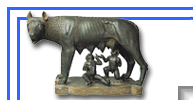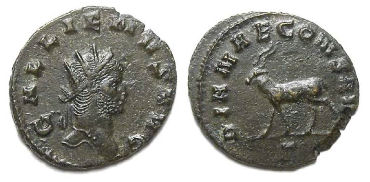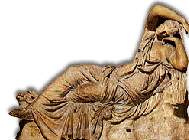 |
 |
ANCIENT ROMAN COINS - Imperial
|
|||||||||||||
|
(Reference: S=Sear Roman Coins and Their Values (2000 edtion), RSC=Roman Silver Coins, RIC=Roman Imperial Coinage, MILNE=Catalogue of Alexandrian coins; GIC=Greek Imperial Coinage by Seaby) |
|
 Philip I, AD 244-249. Bronze sestertius SOLD Order # 1793 |
 Gallienus, AD 253 to 268. Bronze Antoninianus SOLD
Order # 3915
|
 Philip I, AD 244-249. Bronze sestertius. millenium issue.
SOLD Order # 3850 |
 Trajan Decius, AD 249-251. Silver Antoninianus
SOLD
Order # 3924
|
|
(Reference: S=Sear Roman Coins and Their Values (2000 edtion), RSC=Roman Silver Coins, RIC=Roman Imperial Coinage, MILNE=Catalogue of Alexandrian coins; GIC=Greek Imperial Coinage by Seaby) |
|
ALL PRICES ARE IN US DOLLARS
CANADIAN ORDERS MUST ADD GST/HST TO ALL PRICES
FOR ADDITIONAL ANCIENT COINS WE HAVE AVAILABLE
PLEASE SEE OUR VCOINS STORE
www.vcoins.com/calgarycoinNext page of Roman Coins
Top of Page


THE TIME OF CHAOSThe Time of Chaos was aptly named. Starting in AD 235, and continuing for 49 years Rome would be ruled by an ever changing series of good and bad emperors, who were always having to look over their shoulders to see who was conspiring against them. The Empire would suffer through political and economic upheaval, even being temporarily divided during the period of the Gallic Empire. The coinage would be debased until by AD 265 it was mostly worthless copper forced upon the people at the value of silver. This would have been a very bad time to live through, but today it makes for a very interesting series of coins. MAXIMINUS I, AD 235-238Maximinus was a Thracean peasant said to be almost 7 feet tall. He joined the Roman army under Septimius Severus and rose through the ranks to command a legion and eventually became Governor of Mesopotamia. He was a cruel man who lived and died by the sword, murdered by his own troops. This denarii are normally found in very high grade, and as struck examples are not unusual. The bronze sestertii are normally more worn. GORDIAN III, AD 238-244Gordian's silver coinage issued as Augustus are probably the most common of all Roman silver coins, however his issues as Caesar are rare. His bronze sestertii are also fairly common, but all of his smaller denomination Imperial bronze coins are scarce. The details of his six year reign are not well recorded in the history books. We know he was appointed Caesar by Balbinus and Pupienus and proclaimed Augustus by the Praetorians after they murdered them. While on campaign against the Sassanids he was murdered by troops loyal to Philip I, his own Praetorian prefect. Most of the coin issued by Gordian seem to fall into a logical sequence of events, so we have chosen to arrange them here in chronological order under the events they are associated with. There are a few types where the exact meaning is not certain, but we have placed them where we believe they most likely belong. Marriage of Gordian to Tranquilina, AD 241In AD 241 Gordian III married Tranquilina, who was the daughter of the new Praetorian Prefect, Timesitheus. In reality, Timesitheus probably became the real power behind the throne, although he appears to have been happy ruling from behind Gordian as a figurehead. Philip I, AD 244-249This type commemorates the Peace established with the Sassanids (the Romans called them Persians) in AD 244. This was a negotiated peace rather than a Victory, as shown by the slightly unusual reverse inscription. This was alway a relatively scarce type but in recent years the Balkan hoards have made it slightly more common. Most specimens we have seen are weakly struck on the reverse. 1000 th Anniversary CommemorativesOn April 21, AD 248, Rome began the celebration of the 1000th anniversary of its founding. In preparation for this event, a menagerie of exotic animals, from all corners of the Empire, were assembled to display (and we suspect, slaughter) in the Coliseum. Today we can still view these events through the coinage Philip issued to commemorate them. OTACILIA SEVERA, wife of Philip IPHILIP II, AD 244-249Philip II was the son of Philip I and Otacilia Severa. He was given the title "Caesar" in AD 244, and elevated to the rank of "Augustus" in AD 247. VALERIAN I, AD 253-260Valerian, father of the Emperor Gallienus, was a senior government official when in AD 253 he was called to lead an army to aid Trebonianus Gallus in fending off the revolt of Aemilian. When Gallus was killed by his own troops, Valerian's troops proclaimed him Emperor, then march to Italy where they defeated Volusian. In AD 260, Valerian was captured by the Sassanians (lead by Shapur II) who held him in captivity for the rest of his life. |
| Top of Page Copyright © 1997-2005 R & T Enterprises Ltd. |
 |